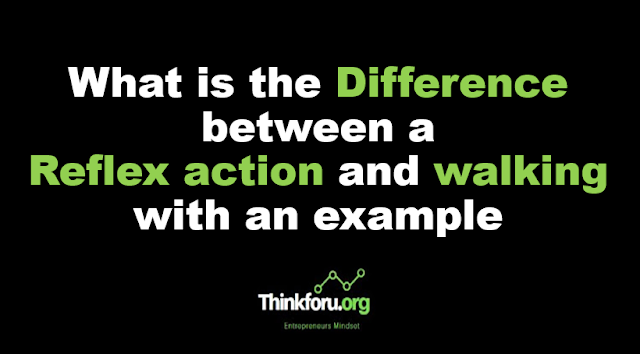What is the difference between a reflex action and walking with an example
What is the difference between a reflex action and walking with an example?
Reflex Action vs. Walking: 10 Differences with Examples
1. Definition:
- Reflex Action: It is an involuntary and immediate response to a stimulus, bypassing conscious thought or decision-making.
- Walking: It is a deliberate, voluntary, and coordinated movement involving the conscious control of muscles to move from one place to another.
2. Voluntary vs. Involuntary:
- Reflex Action: It occurs without conscious control or effort.
Example: Blinking when a foreign object comes close to the eye.
- Walking: It is a voluntary action that requires conscious effort and control.
Example: Deciding to take a stroll in the park.
3. Time Delay:
- Reflex Action: It is usually a rapid and automatic response, occurring within milliseconds.
Example: Withdrawing your hand after touching a hot surface.
- Walking: It involves a deliberate initiation and is a continuous process, not an instant reaction.
Example: Walking from your house to the nearby grocery store.
4. Purpose:
- Reflex Action: It serves to protect the body from potential harm or danger.
Example: Pulling your hand away after accidentally touching a sharp object.
- Walking: It serves as a means of transportation, exploration, exercise, or leisure.
Example: Walking to catch a bus or for recreational purposes.
5. Complexity:
- Reflex Action: It is a simple and pre-programmed response that does not involve higher brain centers.
Example: Yawning in response to seeing someone else yawn.
- Walking: It is a complex motor activity that requires coordination between various muscle groups and the brain.
Example: Balancing on one foot while taking a step forward.
6. Consciousness:
- Reflex Action: It occurs at a subconscious level and does not require conscious awareness or decision-making.
Example: Sneezing when exposed to irritants such as dust or pollen.
- Walking: It involves conscious awareness, intention, and a decision to initiate and maintain the walking motion.
Example: Choosing to walk to your favorite coffee shop instead of driving.
7. Learning and Adaptation:
- Reflex Action: It is an innate, instinctive response that remains constant and does not change with experience.
Example: Jumping at the sound of a sudden loud noise.
- Walking: It can be learned and refined through practice and experience, allowing for improved balance and coordination.
Example: Learning to walk as a baby and gradually gaining more stability and control.
8. Neural Pathway:
- Reflex Action: It often follows a reflex arc, involving sensory neurons, interneurons, and motor neurons.
Example: The knee-jerk reflex, where tapping the knee causes an involuntary leg kick.
- Walking: It involves a complex network of neural connections between the brain, spinal cord, and peripheral nervous system.
Example: The brain sending signals to activate leg muscles and maintain balance while walking.
9. Motor Control:
- Reflex Action: It typically involves a single muscle or a small group of muscles.
Example: Pupillary reflex, where the pupil constricts in response to bright light.
- Walking: It requires coordinated activation of multiple muscle groups, including those in the legs, hips, and trunk.
Example: Extending the leg, flexing the ankle, and maintaining an upright posture while walking.
10. Environmental Interaction:
- Reflex Action: It is usually an immediate response to a specific stimulus without considering the surrounding environment.
Example: The gag reflex when the back of the throat is stimulated.
- Walking: It involves adapting to the changing environment, such as avoiding obstacles, adjusting stride length, and navigating uneven terrain.
Example: Stepping over a puddle or walking
